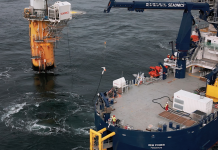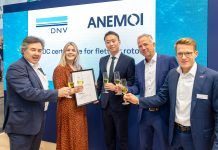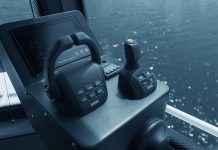Offshore wind farms can tap into a bounty of wind that allows them to work twice as efficiently, but that productivity comes at a cost. Like any sea-based technology, wind farms are difficult to build and expensive to maintain with workers fighting against the same weather that makes the farms work so well onshore. As a result, terrestrial turbines have been steadily gaining ground compared to turbines built at sea. But that may soon change.
Engineers at GE’s Power Conversion business in Nancy, France, have designed an innovative 6-MW direct-drive generator — one of the largest ever built — equipped with a permanent magnet rotor. The design allows them to eliminate the gearbox and reduce the number of moving parts that could potentially break down, leading to easier maintenance. The team also split the electrical drive train into three independent electrical channels so that even if two go offline, the turbine can still operate on one channel and produce electricity.
Low maintenance and redundancy are important, especially for offshore installations where treacherous waters and high winds can delay a repair trip for days or weeks.
“Support vessels cost upwards of $10,000 per day, sourcing spare parts can take time, and trained engineers have to be found in a hurry,” said Frederic Maenhaut, a renewables executive at GE Power Conversion. “Our direct-drive technology mitigates the main risk to the reliability of a wind turbine — the gearbox. When it comes to maintenance costs, that makes a big difference. We developed it to be ideal for an offshore setting.”
The generator weighs 150 tons, measures 7.6 meters in diameter, and sits hundreds of feet above the waves. It draws rotational energy from GE’s Haliade wind turbine and converts it into electricity. The turbine must be large enough to move the big magnet.
The generator and turbine’s first commercial application will be at America’s first offshore wind farm that’s currently being built near Block Island, Rhode Island. Together, they will produce enough electricity to power 5,000 American homes.
GE manufactures the generators in Saint-Nazaire, France, at the same factory that also produces the Haliade turbines. The first GE nacelle with the permanent magnet generator recently left the plant, which can produce 100 of them per year.
The manufacturing process is as innovative as the generators themselves. The machines float down the manufacturing line on an air-cushion system that reduces the need for cranes inside the factory. The site also has its own test bench so that workers can test every generator before it leaves the factory rather than shipping it elsewhere for testing.
According to Maenhaut, the offshore wind market is expected to grow at a rate of 20 percent globally each year through 2020, and he said that he wants GE to be ready.
“Offshore wind is gaining increasing competitiveness in the power mix, and GE is well-positioned to serve this industry,” Maenhaut said.
— Source: GE Reports
For more information, go to www.gereports.com.



























